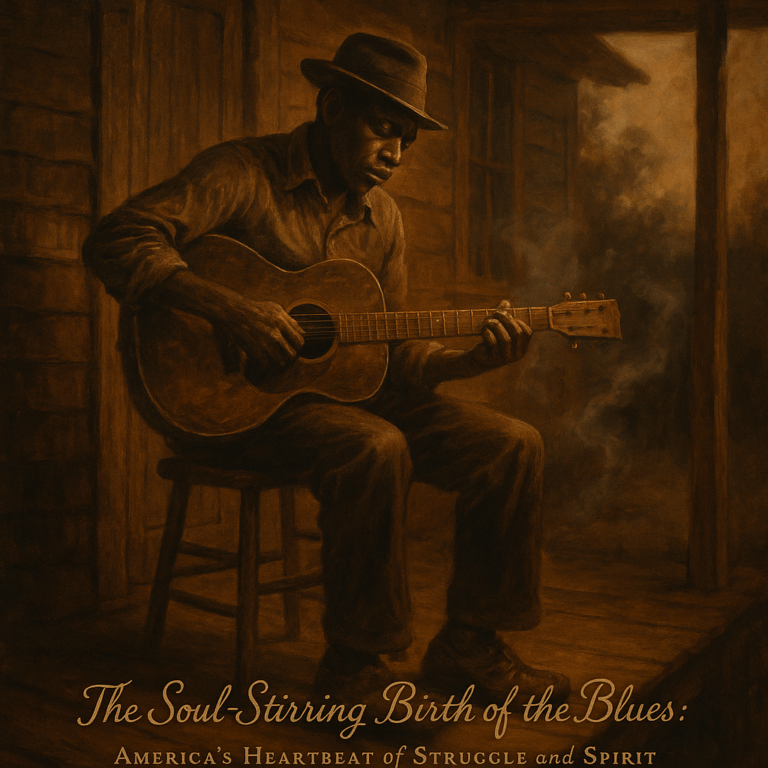The Soul-Stirring Birth of the Blues
In the deep, fertile heart of American music, the blues stands as an indomitable force — a genre forged in the crucible of struggle and spirit. Born in the late 19th and early 20th centuries in the Mississippi Delta, blues music is the raw heartbeat of African American experience, a cathartic river flowing from sorrow and resilience. Envision sharecroppers laboring beneath the blazing sun, their hopes and anguish echoing through cotton fields and juke joints. From spirituals, work songs, and field hollers arose a new, electrifying sound: the blues, the soulful storytelling voice of a people who sang through pain to find freedom.
The blues’ historical context is tightly woven with the aftermath of slavery and Reconstruction-era hardships. It emerged not merely as music but as an emotional lifeline, a way to narrate heartbreak and hardship while asserting identity and hope. Around the turn of the century, the blues traveled out of the Delta on the backs of migrating African Americans, eventually morphing as it mingled with urban life in Chicago and other northern cities. This migration birthed the electrified Chicago blues and further diversified the genre’s palette.
The Rhythm and Soul of the Blues
Blues music pulses with a distinctive structure — the 12-bar blues progression—a looping maze of chords drenched in melancholy, yearning, and resolve. The genre’s expressive power lies in its subtle bends, blue notes, and call-and-response vocals, embodying a compelling tension between pain and beauty. Its instrumentation traditionally features acoustic guitar, piano, harmonica, double bass, and drums. Yet it is the human voice that tells the true story, channeling the bittersweet duality of life’s hardships and fleeting joys.
But blues is far from just sadness. It swings with an earthy groove and a sassy confidence; it is a conversation layered with metaphor and emotion. The genre’s poetry captures everyday struggles—from heartbreak and loss to joy and defiance—with lines that carve deep into the soul. In the mutable language of blues, each note is a living breath, every phrase a testament to survival and spirit.

Giants Who Shaped the Blues Landscape
When you talk blues, towering figures emerge like legends etched into the fabric of American music. Robert Johnson, whose mystical guitar work and anguished vocals shaped the Delta blues, is often mythologized — his story woven with tales of selling his soul at the crossroads to gain supernatural skill. Johnson’s haunting tracks like “Cross Road Blues” and “Hellhound on My Trail” remain touchstones for blues aficionados and rockers alike.
Bessie Smith, the Empress of the Blues, brought a commanding vocal presence that infused the genre with raw emotion and jazz sophistication. Her recordings, such as “Downhearted Blues,” exploded with power, laying groundwork for generations of female blues and R&B singers who followed.
Muddy Waters is the thunderous heart of electrified Chicago blues. As the electric guitar surged to the foreground in the mid-20th century, Waters’ gritty sonics and deeply evocative storytelling brought blues into urban nightlife. Tracks like “Hoochie Coochie Man” and “Mannish Boy” shimmer with swagger and grit, influencing future rock ’n’ roll and R&B icons.
Howlin’ Wolf, with his primal growl and commanding stage presence, pushed blues into a rawer, more intense realm. His songs like “Smokestack Lightning” are hypnotic journeys pulsating with a mesmerizing tension that grips listeners long after the last note fades.
Notable Blues Records That Still Sing
Few albums capture the spirit of blues as profoundly as B.B. King’s 1965 classic, *Live at the Regal*. King’s fluid guitar lines and emotive vocal delivery drape the audience with a warm glow, bridging youthful exuberance with seasoned wisdom. Tracks like “Every Day I Have the Blues” resonate with a timeless intimacy.
Buddy Guy’s *Damn Right, I’ve Got the Blues* (1991) reignited vigor in blues music at a time when rock and other genres dominated the airwaves. Guy’s blistering guitar and flamboyant energy reinvigorated a new generation’s interest, fusing blues with soul and rock elements.
Etta James’ *At Last!* brought an intoxicating blend of blues, jazz, and R&B, defining her as not only a powerful blues vocalist but also a soul icon. The title track “At Last” is an evergreen hymn of love, transcending generations and genres.
Resonating Through the Ages: Blues’ Enduring Legacy
The blues’ influence is woven tightly into the DNA of American music, radiating far beyond its Mississippi roots. It is the foundation stone beneath jazz’s improvisational flights, the wellspring of R&B’s sensual grooves, and the crucial catalyst for rock ’n’ roll’s rebellious roar. Chuck Berry, Jimi Hendrix, Eric Clapton, and Stevie Ray Vaughan all drank deeply from the blues well, carrying its flame into arenas and living rooms worldwide.
Moreover, blues music continues to inform contemporary R&B music’s emotional expressiveness and rhythmic complexity. Artists like Beyoncé, Gary Clark Jr., and Leon Bridges echo bluesy inflections in their vocal styles and songcraft, proving the genre’s vitality in modern soundscapes.
Blues is a genre of storytelling — a musical dialogue between generations, an emotional current tying past to present. It teaches us that through hardship, there is voice, through voice, there is art, and through art, there is transcendence. The scars and sweetness in blues music remind us that the human spirit, much like a haunting guitar riff or a soul-stirring harmonica solo, endures with grace and unyielding passion.
In the end, to immerse oneself in the blues is to feel the pulse of American music’s heart—the interplay of pain and hope, tradition and innovation, solitude and community. It is to recognize that every note played and every lyric sung carries the legacy of those who lived, breathed, and ultimately triumphed through the universal language of rhythm and soul.